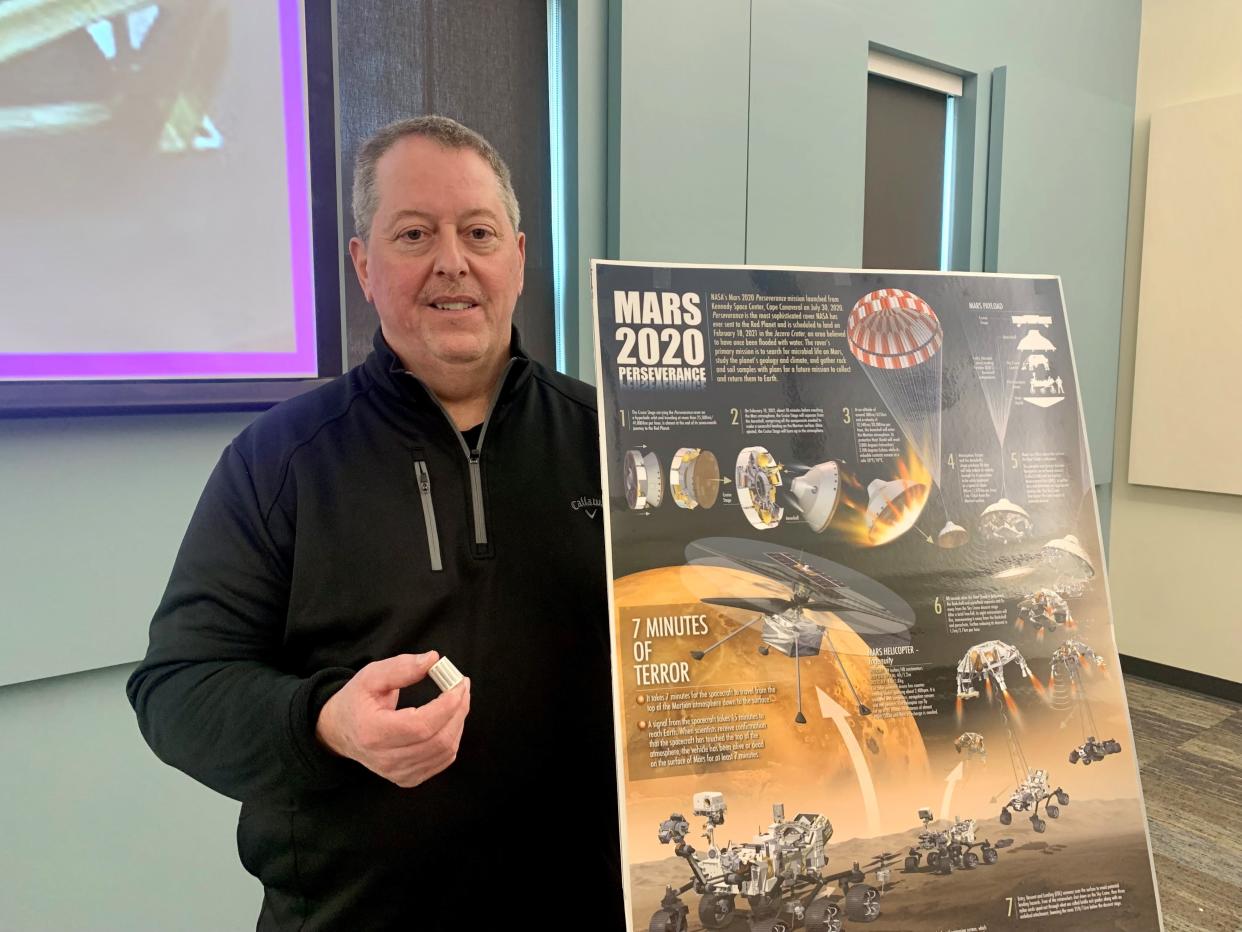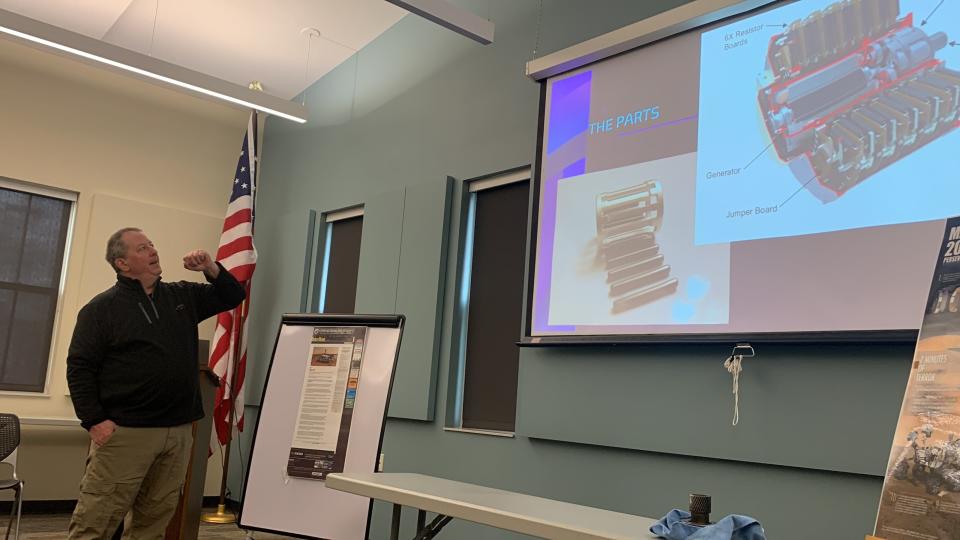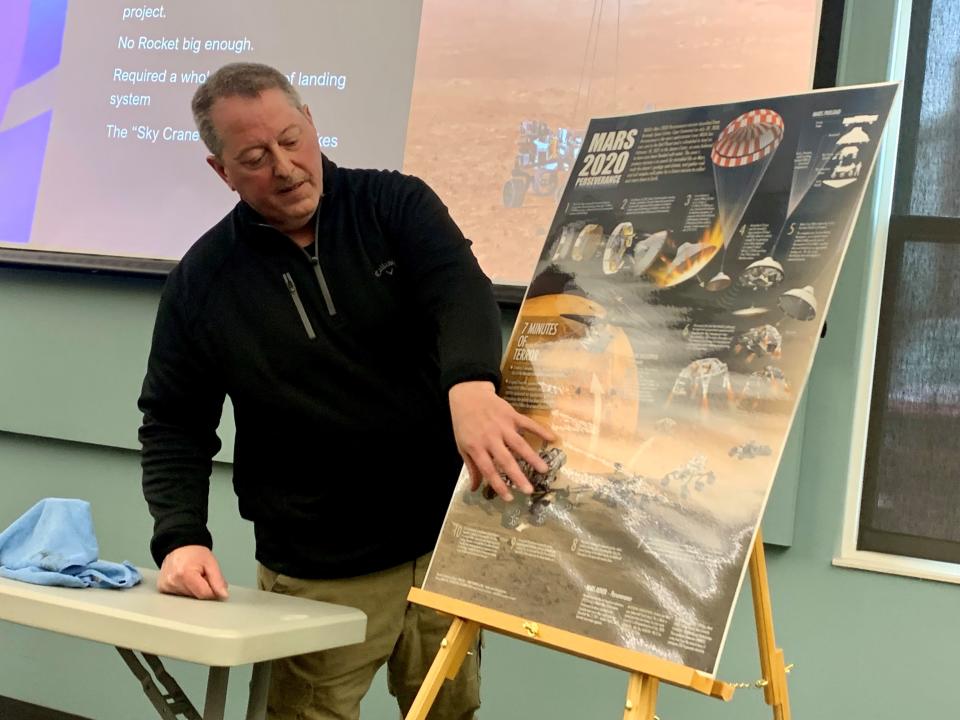From Canal Fulton to Mars: Tim Schlernitzauer helped design Curiosity rover landing gear

CANAL FULTON – Tim Schlernitzauer’s journey to Mars started at the Canal Fulton Public Library.
As a teen, the Northwest High School student would immerse himself in the library’s Time-Life science series.
And as a child growing up during the Space Race, Schlernitzauer was drawn to outer space, coveting the Saturn V rocket model and “My Favorite Martian” and “Lost in Space.”
“It was a constant backdrop to our life,” said Schlernitzauer, who now lives in Perry Township. “… It had a real impact on me.”
Schlernitzauer was part of the Timken Co. team that designed the landing gear for the Mars Curiosity rover, which continues to investigate whether Mars ever had the environmental conditions to support life.
He shared the experiences that led him from Canal Fulton to be involved with a Mars rover during a program Saturday at the Canal Fulton Public Library.
Here are five highlights:
1. Schlernitzauer's first contribution to space came in the 1980s while in Alliance
Schlernitzauer started working as a machine designer at Alliance Machine Co. (now Morgan Engineering) in 1980 and became the lead mechanical designer of the company’s ultra-heaving industrial cranes and other mechanical components.
In 1984, the company designed, built and delivered an overhead crane for the Space Shuttle Assembly Building at Vandenberg Air Force Base in California. The crane was to help lift a space shuttle to a vertical position so it could be paired with rocket boosters.
Schlernitzauer believes the crane still is at the base today.

2. Schlernitzauer needed a special bearings design for Curiosity
As a product designer for the Timken Co., Schlernitzauer helped to design the bearings system that was used to land the Mars rover Curiosity.
Curiosity, launched in November 2011 and landed in August 2012, was lowered to the Mars surface by a sky crane. Schlernitzauer's bearings were part of the crane's descent brake system that used a tether to lower the car-sized rover roughly 65 feet to the surface.
“To lower it was like using a winch, only in reverse,” Schlernitzauer explained. “So, it’s a big brake.”
Schlernitzauer said the bearings for Curiosity had to be designed to be more power-dense than regular ball bearings, which Timken had used in previous Mars rovers. One reason for the smaller bearings that could handle more force was that Curiosity was 10 times heavier than previous models, he said.
Curiosity, which still roams Mars today, also uses Timken bearings in the center hub of its carousel system and to run its vacuum pump, which supports the rover’s analytical equipment, according to the Timken Co.
3. Designing bearings for space came with challenges
Schlernitzauer recalled receiving the specifications for the Curiosity landing gear that said the bearings needed to survive in temperatures up to 200 degrees and in the severe vacuum of space, which can cause some materials to emit gases that can be detrimental if they interact with another material.
“I thought, ‘Wow, what did I get myself into,’” Schlernitzauer recalled.
He said NASA initially specified to use a type of material, which he likened to wood, for the bearing’s casing. He knew it would be too fragile to use, but his boss insisted he try it.
When the material failed, Schlernitzauer said the bearing was designed with a steel casing. It also had a self-lubricating coating to prevent metal-to-metal contact.

4. He regrets not going to watch the Curiosity's launch.
When Curiosity launched from Cape Canaveral, Florida, Schlernitzauer was in Stark County to celebrate Thanksgiving with family. He was given a link to the control tower to watch it live online. If he could do it over again, Schlernitzauer would go to the launch, he said.
“But the most important thing for me is that it went up and landed,” said Schlernitzauer, who left Timken in 2009 as part of the company’s mass layoff of workers. “That fact that something I made was up there. It’s really hard to comprehend.”
5. Schlernitzauer isn’t Canal Fulton's only Mars connection
The leading character in the 1960s television series, “My Favorite Martian,” established Canal Fulton's first connection to Mars when he told his girlfriend that he was born in Canal Fulton.
“Canal Fulton, Ohio? Why didn’t you say so in the first place?" the girlfriend responds in the series about a Martian living on Earth until his spaceship is repaired. "I played there for 16 weeks once. It’s a lovely town."
The Martian then corrects her, “… Canal Fulton, Mars.”
Reach Canton Repository writer Kelli Weir at 330-580-8339 or kelli.weir@cantonrep.com.
This article originally appeared on The Repository: Canal Fulton native designs landing gear for Mars rover

